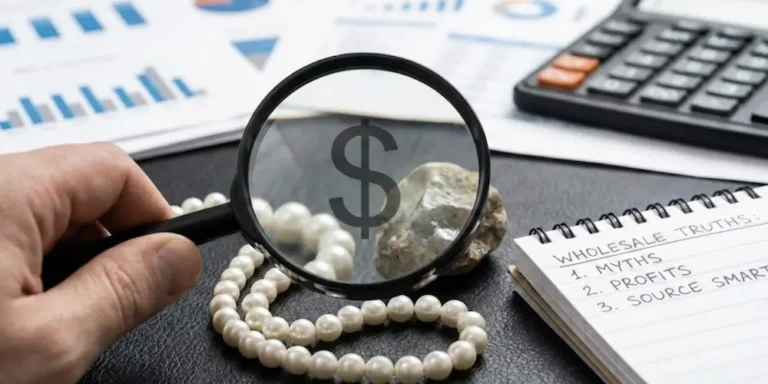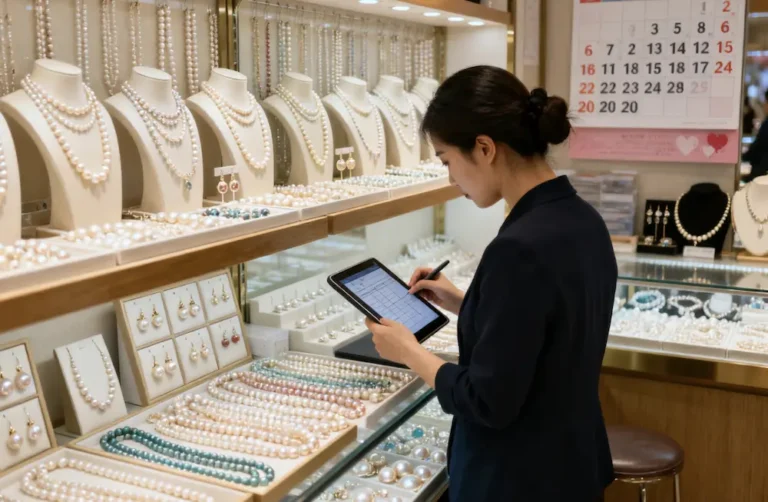What do you think of when you think of a pearl? A lot of people picture a perfect white ball. But here’s something that might surprise you: when exploring pearls colors, you’ll find they come in a wide range of hues, not only white. There are more colors of pearls than you might think. They range from midnight black to golden champagne, from soft pink to uncommon blue.
As someone who loves these natural gems, I’ve spent years learning how pearls colors are created. Let me take you on a trip through the fascinating range of pearl hues, showing you what makes each one special and helping you find the one that would be right for your collection.
What Determines Pearls Colors?
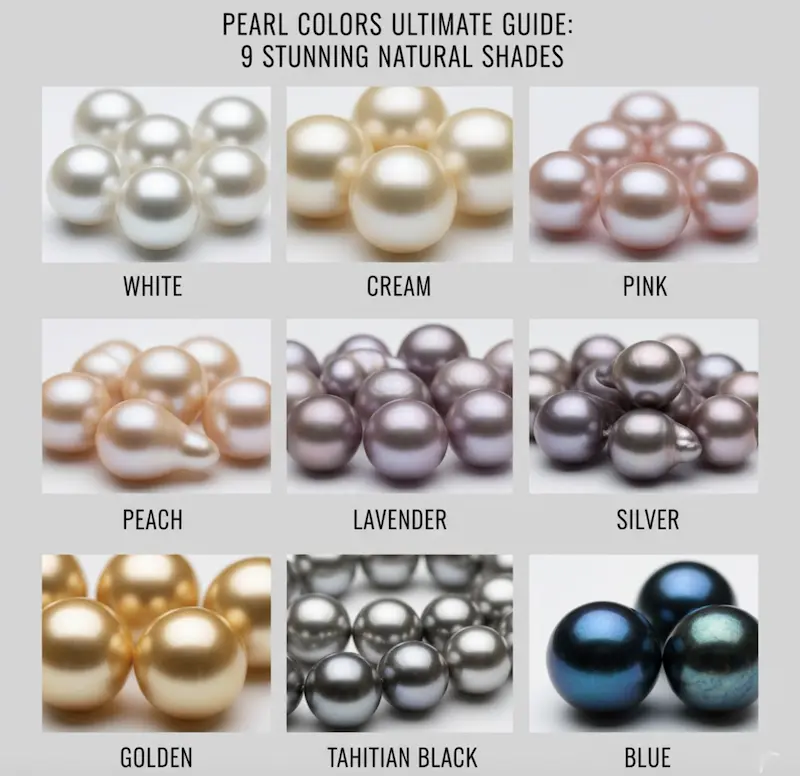
The many pearls colors aren’t random; they’re a wonderful mix of nature and science. Diamonds and sapphires receive their color from the minerals they are made of, but pearls obtain their color from organic processes that occur inside live mollusks.
When a pearl manufacturer grows pearls, the color of the lip typically gives away the color of the pearl that will come out. People often think of Tahitian oysters when they hear the word “pearl.” These oysters, called black-lipped margaritifera, are famous for making the beautiful gray and black pearls that people think of.
The thickness of the nacre is quite important. A study published in Scientific Reports says that the structural hues of pearls come from the way light reflects off of the nanolayered nacre structure. Thicker nacre makes colors that are richer, brighter, and have stronger overtones. When nacre is thin, pearls look milky and don’t have much color.
It also matters what the weather is like. The mollusks’ habitat, the minerals in the water, and even the water’s chemistry can all affect the final pearls colors. That’s why pearls from different places of the world don’t all look the same.
The Complete Spectrum of Pearls Colors
There are a lot of beautiful natural hues in the realm of pearls colors. These are the nine main colors you will find in the pearl market:
1. White Pearls: The Timeless Classic
White is still the most well-known and adored of all pearls colors. However, “white” is far more nuanced than it first appears. White pearls can be warm and creamy ivory or chilly and dazzling silver-white.
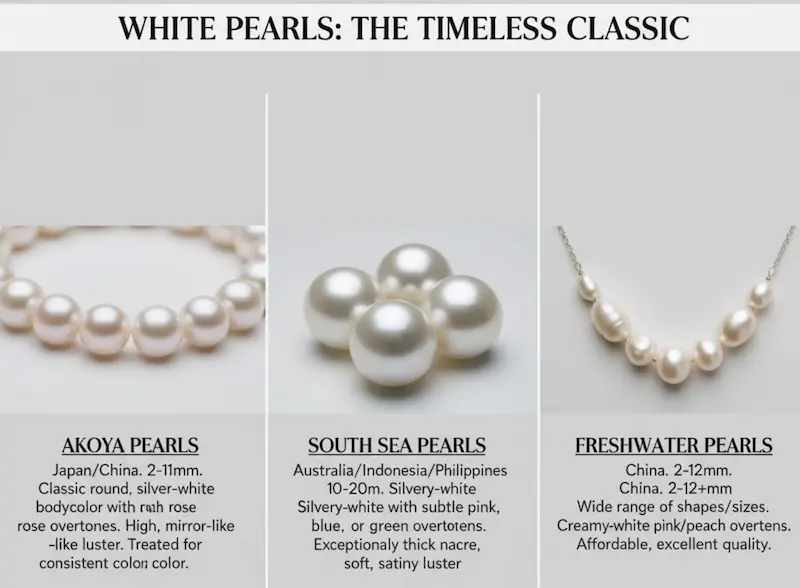
- Akoya pearls: Because they are white with delicate rose overtones, Akoya pearls from China and Japan are well-known around the world. These saltwater pearls, which are between 2mm and 11mm in size, are what most people think of when they think of classic pearl jewelry. The Gemological Institute of America says that a lot of white Akoya pearls are treated with bleaching and “pinking” to get their trademark rose overtone.
- South Sea pearls: Another choice for white pearls is South Sea pearls from Australia, Indonesia, and the Philippines. These pearls are among of the biggest you can find, usually measuring 10 to 20 mm. They are naturally silvery-white with hints of pink, blue, or green.
- Freshwater pearls: Freshwater pearls are the best choice for white pearls that are cheap. These gems are mostly grown in China and come in a wide range of sizes, from tiny 2mm seed pearls to big 12mm+ ones. Their white tint frequently has a hint of cream or pink in it, which makes them appealing with both collectors and jewelry designers.
White pearls have long been a sign of purity, innocence, and faith. This is why women usually wear them on their wedding day. They can be worn at every occasion, from ordinary to formal ones.
2. Black Pearls: Exotic Elegance
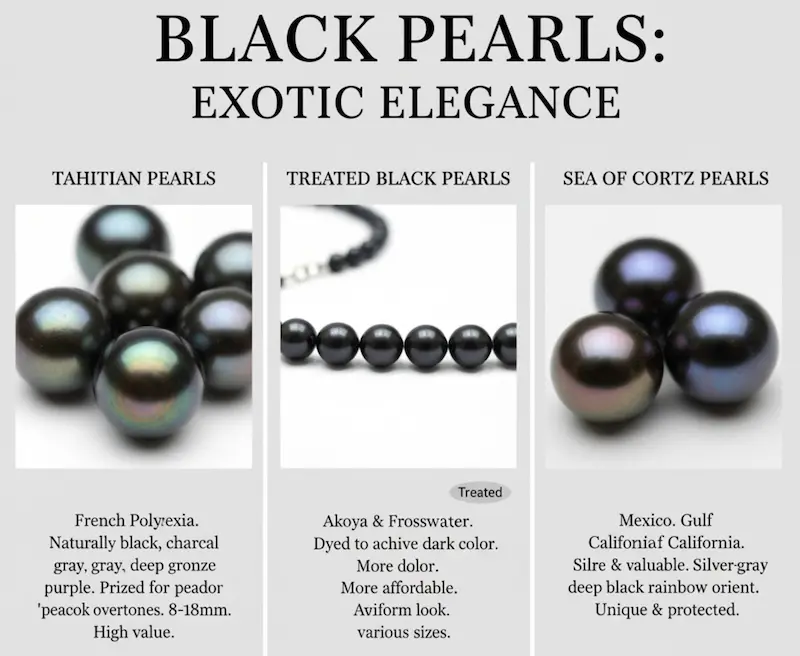
Black is the second most popular hue among pearls colors. These jewels have an air of mystery and elegance about them. True black pearls are actually quite rare in nature.
The most well-known naturally black pearls are Tahitian pearls. These saltwater gems are grown in French Polynesia. They don’t just come in black; they also come in charcoal gray, deep green, bronze, and even purple. The most valuable Tahitian pearls have “peacock” coloring, which means they have a beautiful mix of green, gold, and rose overtones that shine throughout the surface of the pearl.
It’s crucial to remember that not all black pearls are real. Organic dyes give black Akoya and black freshwater pearls their dark color. Treated pearls are just as beautiful and less expensive, but they aren’t worth as much as naturally black Tahitian pearls.
The second type of naturally black cultured pearls are the Sea of Cortez pearls from Mexico. These uncommon gems from the Gulf of California come in a beautiful range of pearls colors, from silver-gray to deep black with rainbow overtones.
3. Golden Pearls: Regal Radiance
One of a kind, golden pearls are warm and hard to find. Golden South Sea pearls, among the most treasured of all pearls colors, are some of the most valuable gems in the world.

The gold-lipped type of Pinctada maxima oysters that live in Australia and the Philippines give birth to these lovely pearls. They can be any color, from light champagne to deep 24-karat gold. The most expensive golden pearls are very bright and have a rich, even color.
Because they are so big, golden South Sea pearls look even more beautiful. Most of them are between 9mm and 20mm across, and some are almost as big as a golf ball! Collectors really want these because they are big, have a rare color, and have thick nacre.
Chinese people put a lot of value on golden pearls. Some people say they fell from the sky during dragon fights, and others say they bring luck, money, and bravery to those who wear them.
When you buy wholesale pearls, the golden ones cost the most. However, if you want a truly unique gem, the price is worth it for their beautiful look.
4. Pink Pearls: Romantic Sophistication
Pink is a soft, girly color that is very popular for pearls. It is a pretty alternative to white among the various pearls colors. In the past few years, these warm colors have become very famous.
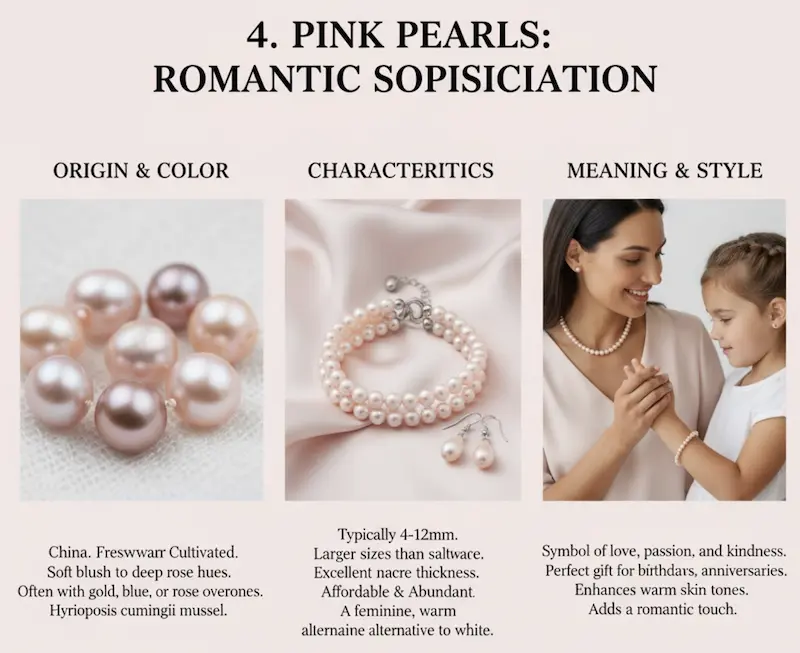
Most pink pearls are made from freshwater pearls that grow in lakes and rivers in China. They are varied colors of pink, from light blush to dark rose. It looks better with blue, green, gold, or rose tones.
The type of mussel that is cultivated, particularly the Hyriopsis cumingii pearl mussel, is what gives pearls their pink color. These pearls are typically much larger than saltwater pearls, measuring 4 to 12 mm across.
Pink pearls are a sign of love, passion, giving, and kindness. They make meaningful gifts for birthdays, anniversaries, or just to show someone you care. Moms love them the most. These pearls colors look great on warm skin tones and give any outfit a romantic touch.
5. Peach Pearls: Warm Sunset Hues
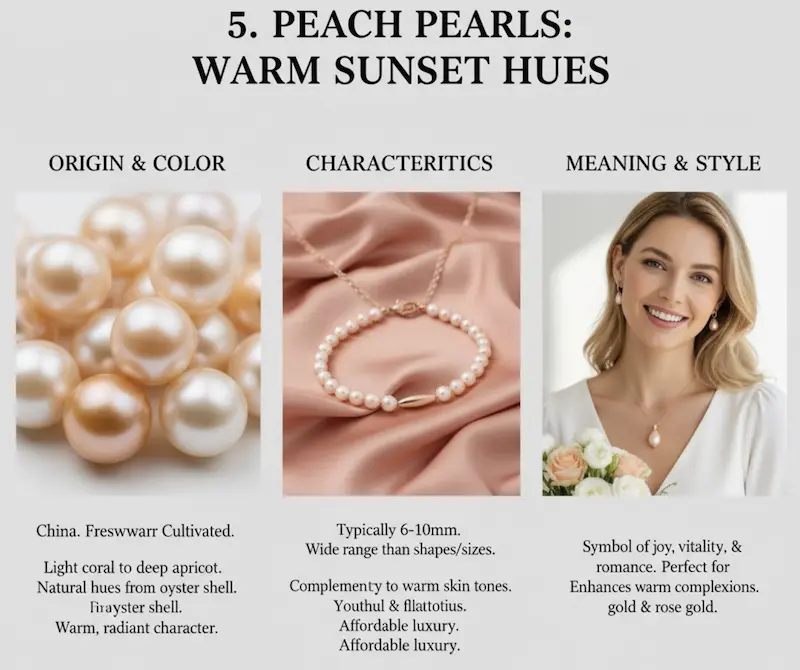
Peach pearls have warmer colors, from light coral to dark apricot. These freshwater types get their peachy color from oysters with naturally peach-colored shells. Their warm, flirtatious nature makes these pearls colors perfect for romantic events.
If your complexion has warm undertones, peach is one of the best pearl hues for you. The gentle apricot glow gives any item of jewelry a youthful look and goes well with both gold and rose gold settings.
6. Blue Pearls: Ocean Treasures
Natural blue is one of the rarest of all pearls colors. Authentic blue pearls can be mild silvery-blue to deep midnight blue, and they often include green or purple undertones.
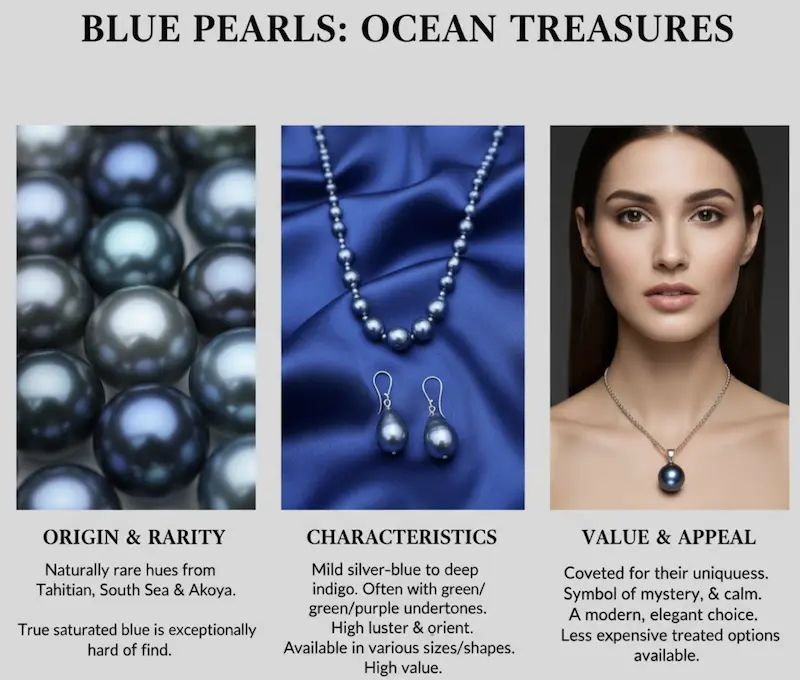
Some Tahitian pearls, silver-blue South Sea pearls, and blue Akoya pearls can naturally show blue tones. But pearls that are really saturated blue are quite hard to find. Experts in the field say that blue pearls have been around for decades but have only recently become popular in jewelry stores.
Natural blue pearls are hard to find, so they cost so much. Look for blue pearls that are very bright and not too expensive.
7. Lavender Pearls: Ethereal Beauty
Jewelry looks light and airy with lavender and purple pearls. Freshwater culture is where these jewels come from. They come in colors from pale violet to deep mauve.

Lavender pearls often have a lot of overtones that make them look like they have changing, complicated colors. Because of their unique tint, they are well-liked by collectors looking for pearls with colors other than the norm.
8. Purple Pearls: Royal Elegance
There are several shades of purple pearls, from grape to deep royal purple. Most of these lovely gems are freshwater sorts that people who want jewelry that is bold and different have really liked.
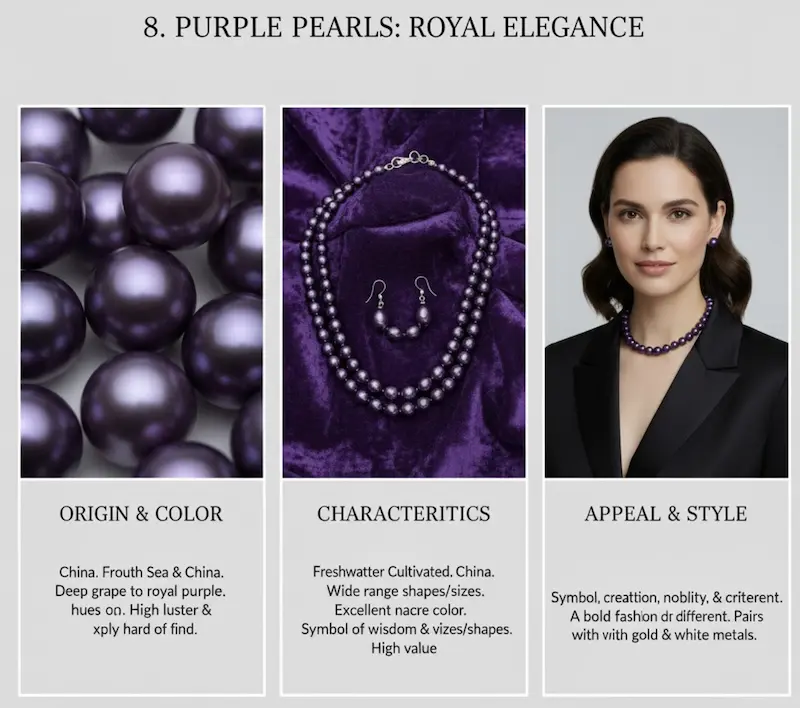
Purple pearls stand for wisdom, nobility, and creativity. They are great conversation starters and standout items.
Understanding Pearl Color Components
Pearls colors are made up of three separate parts that work together to make their end look:
- Body Color: This is the main color of the pearl and the first thing you notice about it. Any color would do, from white to black to gold to pink to blue and everything in between.
- Overtone: These colors are visible and sit on top of the color of the body. There may be a touch of pink, green, or even silver on the surface of a white pearl. Studies indicate that overtones arise from the diffraction of light at the boundaries where nacre crystals intersect. For instance, rose overtones on white Akoya pearls make them more valuable and desirable.
- Orient: This is what you call the rainbow colors that seem to shimmer and alter on the surface of a pearl as it moves or as the light changes. When light bounces off of several layers of nacre, it creates that magical play of color.
Not all pearls display all three components. Every pearl has a body color, but overtone and orient may or may not be present. Pearls showing both overtone and orient are generally more valuable than those displaying only body color.
How to Choose the Perfect Pearl Color
Choosing the color of pearls relies on a number of personal factors, such as:
- Skin Tone Things to Think About: People with cool skin tones (wrist veins that are blue) usually look beautiful in pure white, silver, or black pearls. People with warm skin tones and green veins often shine in cream, golden, pink, or peach pearls. But keep in mind that these are just suggestions; your own choice is always the most important thing!
- Personal Style: White or cream pearls look great with classic or traditional styles. People who are modern and daring might like the black or golden types. Pink and peach tones look good with a romantic style.
- Event: White pearls can be worn to a lot of different events. Black pearls can be worn every day or for a special event. Golden pearls are great gifts for graduations, raises, or other events that honor success.
Price range: Pearls sold in bulk come in a range of prices for different colors. The pink, peach, and white freshwater variants are a wonderful deal. Black and gold Tahitian and South Sea pearls are very uncommon and huge, which is why they cost so much.
Natural vs. Treated Pearls Colors
Before you buy pearls, you should know if their colors are real or have been changed.
Natural colors: When pearls are made, the colors come out naturally; no one helps them except for the growth process. Black pearls from Tahiti, golden pearls from the South Sea, and most white pearls from the South Sea stay the color they were born with. These are worth more on the market.
Treated colors: the colors you see that are “treated” are created after the pearls are harvested, using things like dyes, bleaching, or even irradiation. Here are some of the common ways they do it
- Black Akoya and black freshwater pearls are always dyed (these colors don’t occur naturally in these pearl types)
- Most Akoya white pearls undergo bleaching and pinking treatments
- Deep golden South Sea pearls showing intense metallic sheen are often color-enhanced
- Bright blue, vivid green, or cranberry red freshwater pearls are typically dyed
When purchasing from wholesale pearls suppliers, always ask about treatments. Reputable dealers disclose any color enhancements, allowing you to make informed decisions.
The Value Factor: How Color Affects Price
While color is just one faColor definitely plays a role in how much a pearl is worth, though it’s not the only thing that matters. Size, luster (that lovely shine!), how clean the surface is, and the shape all contribute too. But yeah, color is a factor in the price.While color is just one factor in determining pearl value (alongside size, luster, surface quality, and shape), it does influence pricing.
- Most expensive pearls colors: Natural golden is the most expensive hue of pearls. Peacock and South Sea pearls Tahitian pearls are usually the most expensive since they are rare, big, and have a strong natural color. Also, premium white South Sea pearls are some of the most valuable.
- Mid-range pearls colors: Standard white Akoya pearls, gray Tahitian pearls, and white South Sea pearls with good luster are all mid-range colors that are of high quality and more affordable.
- Value pearls colors: Freshwater pearls in white, pink, peach, and lavender are the finest value. High-quality freshwater pearls can be just as beautiful as saltwater pearls, yet they are less expensive. They are also great for everyday wear.
How rare something is has a big effect on the price. For example, blue pearls that are truly blue can be very expensive. The pearls need to be the same color too. To make a full chain, you need to find several gems of the same color. This makes the string more valuable as a whole.
FAQs
What is the rarest color of pearls?
Natural blue (silver- or steel-blue) Australian South-Sea pearls are the rarest.
What colors of pearls exist?
Pearls occur in white, cream, gold, black, gray, silver, pistachio, aubergine, peacock green, lavender, pink and every shade between.
Which color pearl is best?
“Best” is personal; classic white and rare natural gold command the widest prestige.
What color pearls are worth the most?
Intense natural gold South-Sea and natural-color peacock green Tahitians fetch the highest prices per carat.
Conclusion: Your Perfect Pearl Awaits
There are many different kinds of pearls, so everyone can pick one that fits their style and budget. White, black, pink, and royal gold are just a few of the beautiful and meaningful pearls colors out there.
You might be able to make wise, sure decisions if you know about the numerous colors of pearls. This is true no matter if you enjoy the classic beauty of white Akoya pearls, the exotic look of black Tahitians, the warm glow of golden South Sea gems, or the romantic look of pink freshwater pearls.
If you work with skilled Pearl Manufacturer providers and sources you can trust, you can be sure to find real gems that will last for years. Remember that the “best” pearl color is the one that looks good on you and makes you feel good.
Take some time to look at the wide range of pearls colors that are available today. Put different colors on your skin and see how they make you feel. Then, trust your gut. Pearls are very personal gems, and your perfect pearl is out there somewhere in that beautiful range of natural colors.


